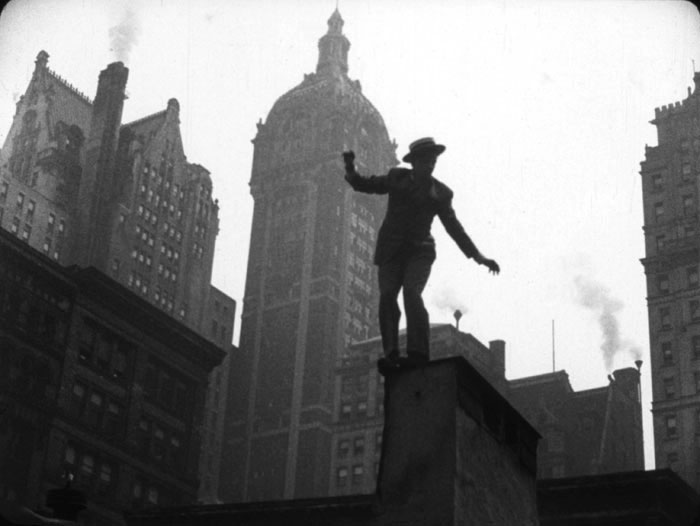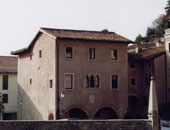Too Much Johnson by Orson Welles Found in Italy
 |
|
Joseph Cotten as Billings during the madcap chase across Manhattan in Orson Welles's Too Much Johnson (1938), produced for the Mercury Theatre's stage production. CLICK HERE for more images.
|
In 2013 the National Film Preservation Foundation, George Eastman House, the Cineteca del Friuli, and Cinemazero announced the recovery of Orson Welles’s long-lost Too Much Johnson (1938), filmed two years before the celebrated American director went to Hollywood to make Citizen Kane (1941).
As a member of the Mercury Theatre, Welles created silent comedy shorts starring Joseph Cotten, Arlene Francis, and Ruth Ford for the Theatre’s innovative 1938 revival of the 19th-century farce by William Gillette. Never finished, the films did not screen publicly and took on legendary status when the single known print reportedly burned.
Though barely twenty, Welles had already rocketed to national fame through his Federal Theatre Project productions of “Voodoo” Macbeth and The Cradle Will Rock before cofounding the Mercury Theatre with John Houseman in 1937. Their first production, a restaging of Julius Caesar in fascist Italy, was an immediate Broadway hit. For Welles, Too Much Johnson provided another opportunity to rethink a theatrical warhorse for contemporary audiences. He turned the long-in-the-tooth marital farce of mistaken identities into a lightning-paced screwball comedy and shot three short movies to give the back story before each act.
"The discovery of the long lost footage from Orson Welles's out-of-town production of Too Much Johnson is thrilling, a very significant missing piece in the jigsaw of Welles's art,” said Simon Callow, the celebrated British actor and writer. “It was filming these sequences that first made him fall in love with film; here he began to discover the possibilities not only of shooting but of editing. It will tell us an enormous amount about his visual sensibility and indeed about his theatrical instincts; at last we can really get a sense of what this recklessly inventive production for the Mercury Theatre might actually have been like had the film been used.” Mr. Callow is now at work on the third and final volume of his definitive biography of Welles.
An abandoned 35mm nitrate work print of Too Much Johnson, found in a warehouse in Pordenone, Italy, was salvaged by Cinemazero, the film exhibition organization that partners with the Cineteca del Friuli to present the city’s annual silent film festival. Given the importance of Too Much Johnson for American stage and film history, the two organizations invited Eastman House and the NFPF to work with them to preserve the film. Eastman House directed the preservation to 35mm film, which was funded through the NFPF, and hosted the American premiere on October 16, in Rochester, New York.
It has long been said that Paramount Pictures, which owned the movie rights to Too Much Johnson, quashed Welles’s movie adaptation after he began shooting, a claim that could not be substantiated by Paramount in a recent search of its archives. Another account suggests that the highly flammable nitrate film could not be safely shown in the Stony Creek Theater in Connecticut, where the play opened. Whatever the reason for dropping the film, the play opened without it on August 16, 1938, and flopped. Undeterred, Welles went on to produce the celebrated radio broadcast of War of the Worlds later that year.
While none of the three parts of Too Much Johnson reached final cut, the surviving work print reveals a master in the making. The longest and most finished piece, the act 1 prologue, shows the philandering Billings (Joseph Cotten), who has been womanizing under the name of Johnson, chased at breakneck speed across Manhattan by a wronged husband. Two shorter segments establish the death of Billings’ friend in Cuba and the complications caused when too many Johnsons turn up there. (To view the work print, click here. For a “reimagining” of how the films might have been put together had they been completed, click here.) A 16mm home movie from one of the Mercury Theatre’s many investors, and now at UC Berkeley Art Museum and Pacific Film Archive, documents the exuberant Welles shooting on location in the Hudson Valley.
To find out more about “lost” American films found abroad by the NFPF and available on DVD, click here.
 |
 |
 |
||
| Only known footage of "Voodoo" Macbeth | Earliest footage of Welles as film director (Courtesy of BAM/PFA) | About Our Partners |
